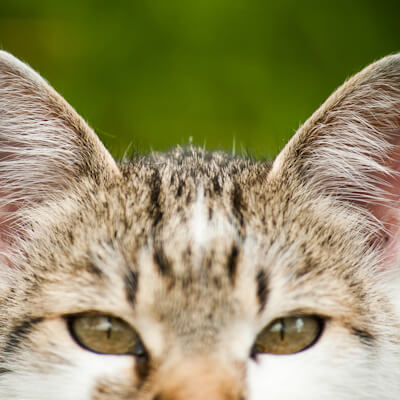
A cat’s ear is quite a different shape to ours. Humans simply have a horizontal tube that runs straight from the side of the head into the inner ear (auditory canal). In the cat, however, the outside opening of the ear canal is high on the side of the head. The canal runs vertically down the side of the head and makes a sharp right angle into the inner ear. Foreign bodies (usually grass seeds) can get stuck in the ear canal and infections may develop. Most often ear disease in cats is caused by a type of mite which lives inside the ear canal.
Cats can also get diseases that affect the skin of the ear flap. Solar dermatitis is an irritation caused by sun burn on the ear tips which causes crusting and scabbing. This must be treated early as it can lead to cancer of the ears later in life if left untreated.

Owners may not notice ear disease until it is severe. Your cat may shake its head from side to side, or may be forever stopping to sit down and scratch its ears.
Ear mite infestation tends to make cats scratch at their ears and shake their heads. You may notice a very dark, almost black wax in the ear canals. Some cats produce so much wax that the ear canal becomes totally blocked. However, many cats carry ear mites without showing any signs. Ear mites should always be treated otherwise bacterial infections may develop and aggravate the problem. The lining of the ear is very delicate and a long-standing problem can cause permanent scarring.
Sometimes a cat will shake their head so much that they burst a blood vessel and develop a swelling in their ear flap – a haematoma. If this happens your cat will probably need an operation to drain the swelling.
In many types of infection there is a smelly discharge or the ear canal may be full of black wax. Ear disease can be very painful, sometimes animals with sore ears will sit with their head tilted to one side, they may be off their food or generally miserable.
Even if your cat has had problems with its ears in the past it is very important that your vet examines them each time a problem occurs. There may be damage deep within the ear, or a foreign body such as a grass seed stuck in the ear. If there is something stuck in the ear it can cause permanent damage if not removed.
To examine the ears properly your vet will need to put an instrument called an ‘otoscope’ inside the ear. However, the inside of the ear is very sensitive and many cats will not allow sore ears to be examined unless they have been sedated or even anaesthetised.
Once ear disease develops your cat will need some treatment to stop the irritation. Treatment will vary depending on the cause of the problem. Obviously a foreign body will have to be removed, and specific treatment may be required for mites or nasty infections.
When one animal is affected by ear mites it is necessary to treat all the in contact animals in the house, even if they’re not obviously affected. If these are not treated then re-infection is likely. Fortunately the treatment of ear mites in cats is simple. Application of a single ‘spot-on’ treatment to the back of the neck should be sufficient (although the dose may need to be repeated a month later in some cases.
Your vet may need to take samples from your cat’s ear to decide which is the best treatment to give. Treatment is usually with ear drops and possibly also some tablets. However, unless the ear is clean the ear drops cannot work. It may be necessary for your vet to admit your pet to the hospital and clean out its ear canals before treatment starts. In less severe cases, your vet will show you how to use an ear cleaner.
Always make sure you follow your vet’s instructions carefully. You must complete the treatment course even if the ears seem to be much better after one or two days.
No! Never put anything into your pet’s ear without first consulting your vet. Even if the drops were prescribed for your pet in the past they may do more harm than good on this occasion. Many types of ear drop deteriorate once they have been opened, or it may be that the ear problem is caused by something different this time. Remember that ear disease is very itchy and can be very painful – you must always seek veterinary treatment sooner rather than later for the sake of your pet.
It is unlikely that ear disease will get better on its own. The longer you leave it before starting treatment the harder it becomes to clear up the irritation. Each time ear disease develops, more damage is done and eventually the walls of the ear canal may become thickened. This makes further infections more likely as fresh air cannot get to the bottom of the ear canal. When ear disease keeps coming back, surgery may be needed to remove part of the wall of the ear canal so that treatment can get to the site of infection.
Unfortunately some animals are just more prone to ear problems than others. Cats with growths within the ear canal may be at risk of developing repeated infections. Animals with allergies frequently have recurring ear problems. The lining of the ear is like the skin on the rest of the body and can become itchy and inflamed in an allergic cat.
Unfortunately it is impossible to prevent ear disease coming back in some animals. You should check your cat’s ears regularly and contact your vet if the ears become red or sore looking. Regular ear cleaning can be helpful in removing debris and wax within the ear, but excessive cleaning may damage the inside of the ear and make infection more likely.
In most cases of ear disease the symptoms will clear up within a few days of treatment starting. Unfortunately this is not the end of the problem. It is highly likely that the problem will come back at some stage in the future and you should be on your guard for it. If the problem recurs, seek advice from your vet as soon as possible because if the disease is allowed to go untreated for any length of time, permanent damage may result.




